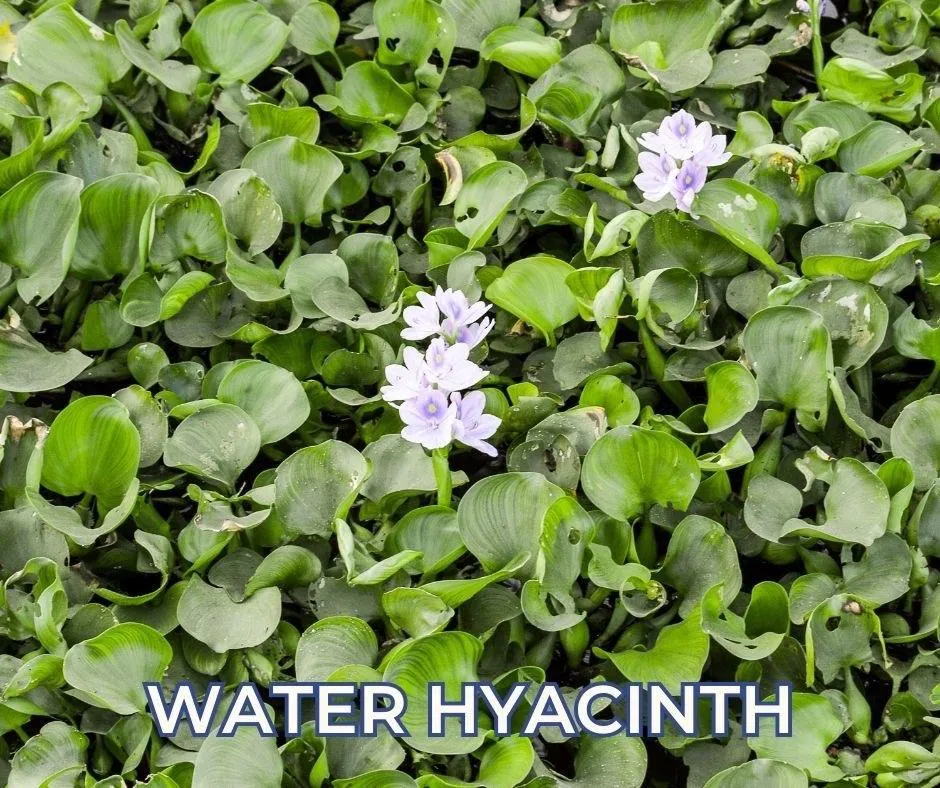What is Water Hyacinth? Impact, Benefits, and Control

Water hyacinth (Eichhornia crassipes) is a vibrant, free-floating plant with thick, glossy leaves that cluster in rosette shapes. Known for its bluish-purple flowers, this plant was initially introduced to water gardens for its beauty. However, its rapid growth has made it one of the most invasive aquatic plants worldwide, often disrupting pond ecosystems by covering large surface areas. While it absorbs nutrients and can benefit water quality, water hyacinth’s fast spread often causes more harm than good.
Characteristics of Water Hyacinth
Water hyacinth is a perennial that grows in freshwater environments, including ponds, lakes, and slow-moving rivers. It has long, dense roots that dangle in the water, creating a cozy habitat for small fish and invertebrates. Although it produces seeds, the plant primarily spreads through asexual reproduction. Each plant can produce “daughter” plants via stolons (horizontal stems), leading to exponential growth. Under favorable conditions, it can double its coverage in as little as two weeks, quickly overwhelming ponds and outcompeting native plants for resources.
Why is Water Hyacinth Bad?
While water hyacinth can help filter excess nutrients from the water, its invasive growth poses several ecological challenges:
- Blocks Sunlight: Thick mats of water hyacinth shade submerged plants, limiting their access to sunlight. Without light, these plants cannot perform photosynthesis, which affects oxygen production and harms fish and other aquatic life.
- Reduces Oxygen Levels: As it decomposes, water hyacinth releases nutrients back into the water, which can fuel algae blooms. Algae growth depletes oxygen further, leading to low oxygen conditions that stress or kill fish.
- Increases Flooding Risk: Mats of water hyacinth can block water flow, leading to stagnation and even increasing flood risk in nearby areas.
Because of these impacts, water hyacinth is often considered a nuisance species, especially in ponds where balanced plant life is essential to maintaining healthy water quality and biodiversity.
Should I Remove Water Hyacinth from My Pond?
If water hyacinth covers much of your pond’s surface, removing it may be necessary to protect other plants and aquatic life. Signs that removal might be needed include:
- Reduced water clarity and oxygen levels
- Thick mats covering most of the water’s surface
- Decreased fish activity or visible stress
When removal is warranted, it’s essential to use eco-friendly methods that won’t harm other pond plants or animals. Consider consulting Pond Doctor for assistance in managing or removing water hyacinth safely. Our team can recommend solutions to restore balance without causing damage to the pond’s ecosystem.
How to Get Rid of Water Hyacinth
There are several methods for controlling water hyacinth growth:
- Manual or Mechanical Removal: Regular skimming or use of specialized equipment can clear water hyacinth from the pond’s surface. This method provides quick results but requires frequent maintenance.
- Biological Control: Introducing natural predators like weevils and specific moth species can help manage the plant’s growth without harming other species.
- Chemical Control: Herbicides may be effective for larger infestations, but they should be used with caution to avoid impacting native plants and wildlife. For a safer approach, our Chemical-Free Pond Cleaning services provide an eco-friendly solution to managing invasive plants.
Each method has its benefits, and selecting the right one depends on the pond’s size and your goals for plant management. For extensive infestations, Pond Dredging may also be an option, as it helps remove organic buildup where water hyacinth tends to thrive.
Final Thoughts
Water hyacinth can offer some benefits to ponds but often creates more issues than it solves due to its rapid spread and impact on native plants and water quality. Monitoring its growth is essential for pond owners. If water hyacinth begins to cover too much of your pond, Pond Doctor can provide professional removal services to restore your pond’s health. Contact us to learn more about our eco-friendly solutions for managing invasive plants effectively.
